Llandudno and Colwyn Bay Electric Railway
Summary
The Llandudno and Colwyn Bay Electric Railway, which was owned and operated by the Llandudno and District Electric Tramway Construction Company Limited, opened to the public on the 19th October 1907.
The overhead electric tramway, which was built to a gauge of 3ft 6ins, had had a long and very problematic gestation. Although powers had been obtained as far back as 1899, a fundamental lack of capital led to a succession of false starts, with various companies (both new and restructured) promising and failing to build the authorised tramway; even when construction did start — in late 1903 — it ultimately ended up with the latest incarnation of the company (the Llandudno and Colwyn Bay Electric Traction Company) entering liquidation. The L&CBETCo's assets and powers were subsequently acquired by the L&DETCCo, a company which was, at last, adequately capitalised to deliver on its promises.
At its maximum, the tramway was 8.38 miles long, and ran roughly southeastwards — paralleling the coast — from West Shore in Llandudno along the town's main thoroughfare, crossing inland behind the Little Orme and Rhos-on-Sea, through Colwyn Bay to a terminus near the Queens Hotel in Old Colwyn. Services initially ran between West Shore and the tramway depot near Rhos-on-Sea, but were subsequently extended to Station Rd in Colwyn Bay on the 7th June 1908, and finally, to Old Colwyn on the 26th March 1915.
The tramway dealt with extremely heavy loadings during summer, employing scores of seasonal staff, but operated a much-reduced timetable during the winter months. It quickly proved to be a profitable concern, changing its title in 1909 — to the Llandudno and Colwyn Bay Electric Railway Limited — no doubt to better reflect the fact that it was a tramway operator rather than a constructor. The company's profits had however not escaped the notice of others, and in the same year, a significant stake in the L&CBER was acquired by Balfour Beatty and Company. At this time, BB&Co was actively promoting, purchasing, or acquiring interests in several provincial tramways and electric supply undertakings across the country, a policy which would eventual see it control the following systems: 1909 (Dartford Council Light Railways; Dunfermline and District Tramways; Llandudno and Colwyn Bay Electric Railway; Llanelly Tramways; Luton Corporation Tramways); 1911 (City of Carlisle Electric Tramways); 1912 (Leamington and Warwick Electric Tramways; Mansfield and District Light Railway; Nottinghamshire and Derbyshire Tramways); 1914 (Cheltenham and District Light Railway); 1920 (Falkirk and District Tramways); and lastly, in 1922 (Wemyss and District Tramways).
Other than the appointment of board members, BB&Co seem to have been content to let the company continue operating the tramway much as it had done before. The tramway therefore continued with its busy but uneventful life, save for deteriorating relationships with the two local authorities — Llandudno Urban District Council, and Colwyn Bay & Colwyn UDC — with complaints about the track, squealing trams and traffic obstruction being common.
After the rigours of the Great War, which no doubt included a significant maintenance backlog, and life-expired infrastructure, the company managed to find the money to purchase a number of second-hand tramcars, and over the course of the ensuing decade, the line was doubled and the overhead was completely replaced. The tramway was however also exposed to the full force of unregulated bus competition; this, along with significant difficulties in operating between Colwyn Bay and Old Colwyn, which at this time was the main coastal road, led the company to abandon this section, the eastern terminus being cut back to Greenfield St in Colwyn Bay on the 22nd September 1930.
The tramway toyed with conversion to trolleybus operation in the early 1930s, but decided to continue with the trams, probably because it could not afford the high-cost of removing the rails and making good the roads, as it was required to do by law. A switch to bus operation however, cannot have been very far from the directors' thoughts, a mind set that saw more second-hand trams (as opposed to new) arrive during the 1930s.
The Second World War brought more pressures, including increased passenger numbers due to the relocation of government offices (and their workers) to the area. After the war, the company seems to have been happy to continue running the tramway on a make-do-and-mend basis, as long as it made a profit, however, Llandudno UDC were far from happy with the state of the track, and when profits turned to losses in the early 1950s, the writing was clearly on the wall.
The end was hastened by the local electricity board — MANWEB — which was demanding a significantly higher price for electricity when the L&CBER's contract was up for renewal in the summer 1956. Tramway closure was therefore brought forward, the last tram running on the 24th March 1956, company buses replacing them the next day.
Uniforms
It is currently unclear what uniforms were worn in the earliest years of operation (1909 to 1920), as photographs showing staff are surprisingly rare; what has survived however, suggests that tramcar staff may have been issued with single-breasted jackets with five buttons and upright collars. From the 1920s onwards, the photographic record is increasingly rich, and it is clear that both conductors and motormen wore double-breasted jackets with four pairs of buttons (plain with scalloped rims — see link). The earliest jackets had an extra pair of buttons that could be buttoned through the lapels, as well as three hip-level pockets with flap closures; the collars were left plain, i.e., they bore no badges. By the 1930s however, the jacket style had altered slightly, with the top pair of buttons now mounted between the lapels and the collars, and with two hip-level pockets; the bearer's right-hand collar now bore system initials in individual metal initials — 'L C B E R' — probably in nickel.
Caps were in a military style with a glossy peak and tensioned crown (top); they bore script-lettering grade badges — either Conductor or Motorman — though in later years Driver frequently made an appearance.
Motormen and conductors were also issued with double-breasted greatcoats for use in more inclement weather, and light-weight coats for summer use (colour photos suggest that the latter may have been light grey, though this is uncertain). Both types of coat appear not to have borne any insignia. White rain covers were also worn on the caps in summer.
In common with a small number of other seaside tramway systems, so-called 'Jumper' conductors were employed in the summer months; the name stems from the practice of jumping from tramcar to tramcar to assist the resident conductors in fare collection on the heavily patronised summer trams. They usually worked the eastbound services from Palladium Corner, either doing the top deck of the double-deck cars or helping out on the toast-racks, before alighting at or before Craig-y-Don, then riding back (as a passenger) to Palladium Corner to start all over again (with thanks to John Bird for this information).
Photographic evidence of inspectors is relatively thin on the ground, but what little there is (post World War Two) indicates that they wore double-breasted jackets with two rows of black buttons (probably unmarked), two waist pockets and lapels. The jackets appear to have borne 'L C B E R' in embroidered lettering on the right-hand upper lapel, whilst the left possibly bore Inspector, again in embroidered script lettering. Caps were similar to those worn by tramcar staff, but bore Inspector in embroidered script lettering on a hatband, rather than the metal badge issued to tramcar staff.
Although female staff were employed by the vast majority of tramways during the Great War — to replace male staff lost to the armed forces — it is believed that the L&CBER never did so (thanks to Keith Turner for this information). In contrast, they certainly employed conductresses during the Second World War, and continued to do so in the post-war years, though photographic evidence is frustratingly sparse. What little exists seems to show that these ladies wore jackets that were similar to their male colleagues, but appropriately tailored, along with trousers.
Further reading
For a history of the system, see: 'The Llandudno and Colwyn Bay Electric Railway' by Keith Turner; The Oakwood Press (2007).
Images
Motormen and conductors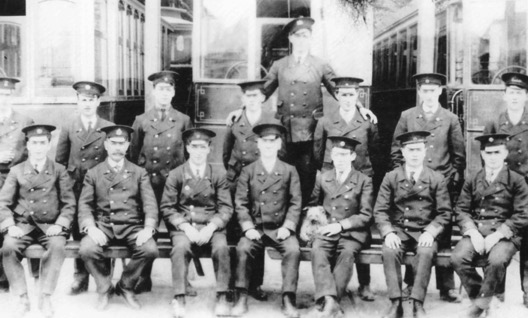
A poor-quality but rare photo of L&CBER staff taken at the depot in Rhos — very probably taken shortly after the Great War, given that the vast majority of those pictured appear to be wearing regimental badges. Author's Collection.
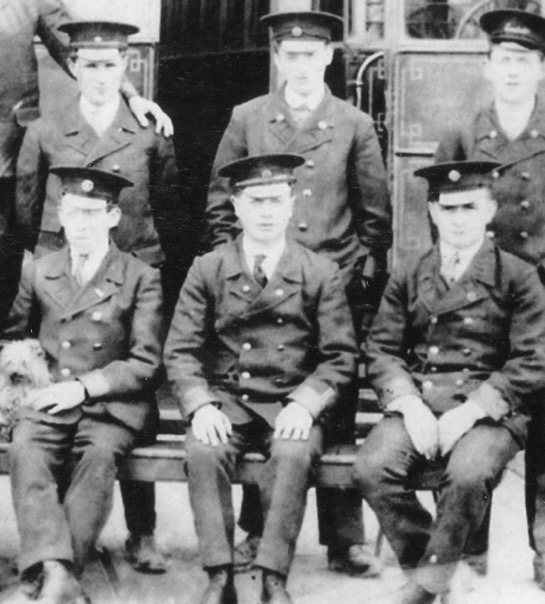
A blow-up of the above photo showing some of the motormen and conductors. The individual at the back right is the only one depicted wearing a script-lettering grade badge, all the rest are wearing regimental badges, a common practice after the Great War for those who had served. The jacket collars are completely devoid of insignia.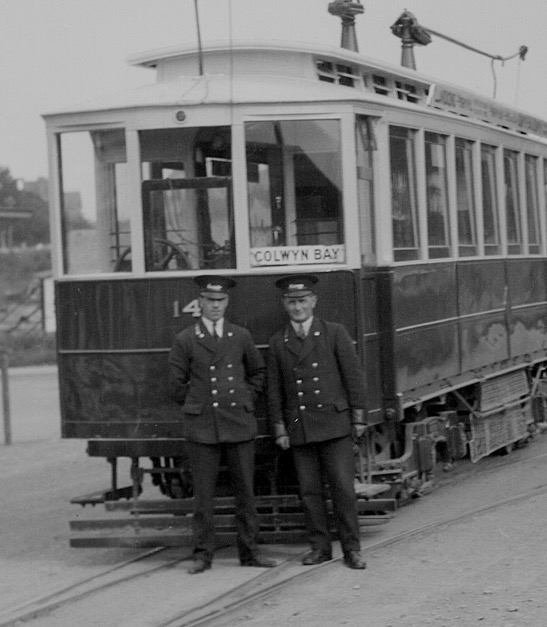
A conductor and a motorman pose in front of Tramcar No 14 in Penrhyn Avenue in Rhos, formerly Tramway Avenue, on 21st May 1933. Photo by H Nicol, courtesy of the National Tramway Museum. 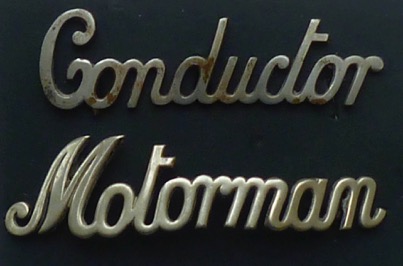
Script-lettering cap badges of the pattern worn by Llandudno and Colwyn Bay Electric Railway staff — nickel. Author's Collection.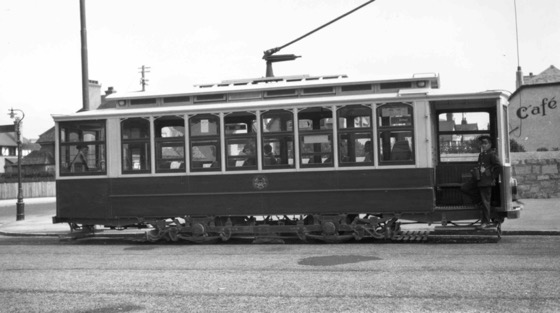
An unidentified L&CBER tramcar captured on the 21st May 1937, possibly somewhere along Tramway Avenue, Rhos. Photo by H Nicol, courtesy of the National Tramway Museum. 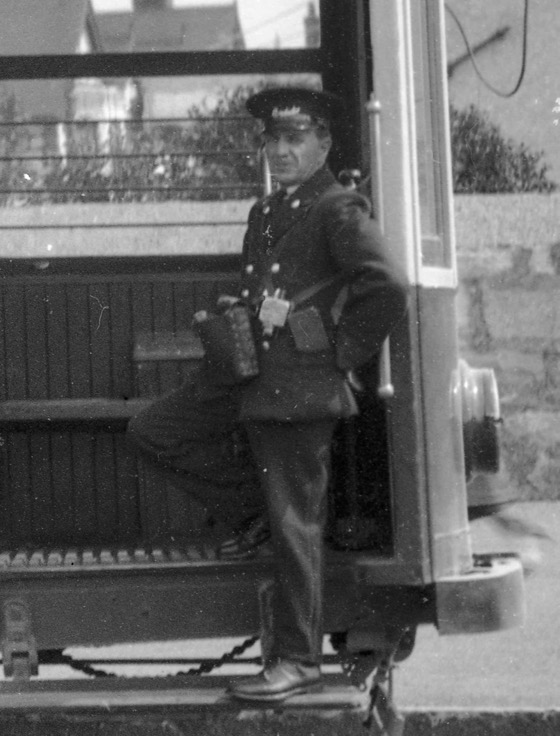
A blow-up of the above photo showing the conductor, who is wearing a smart, double-breasted jacket with a military-style cap bearing a script-lettering grade badge.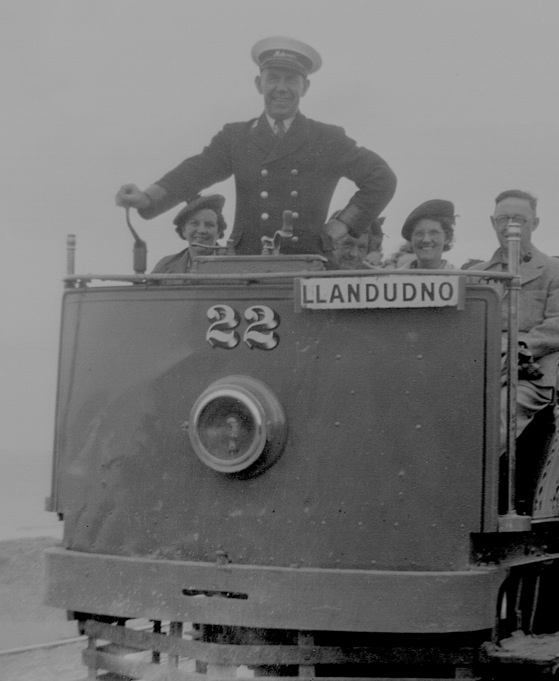
A motorman poses for the camera at the controls of Tramcar No 22 at Craigside — photo undated, but almost certainly taken in the 1950s. Photo by N Willis, courtesy of the National Tramway Museum.
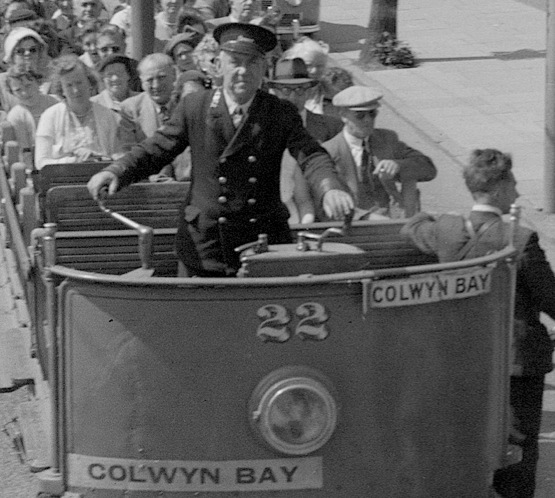
Tramcar No 22 again, this time in Conway Rd on 30th May 1955. Note that the motorman is wearing a Driver script-lettering cap badge. The bearer's upper right-hand lapel appears to bear individual metal initials 'L C B E R'. Photo by M J O'Connor, courtesy of the National Tramway Museum. 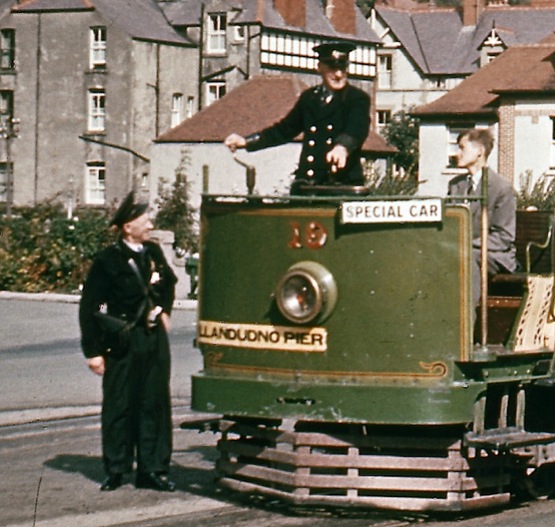
A conductor and a motorman with Tramcar No 19 at the Llandudno end of Gloddaeth Street in 1956. Photo courtesy of the Tramways and Light Railway Society, with thanks to David Voice.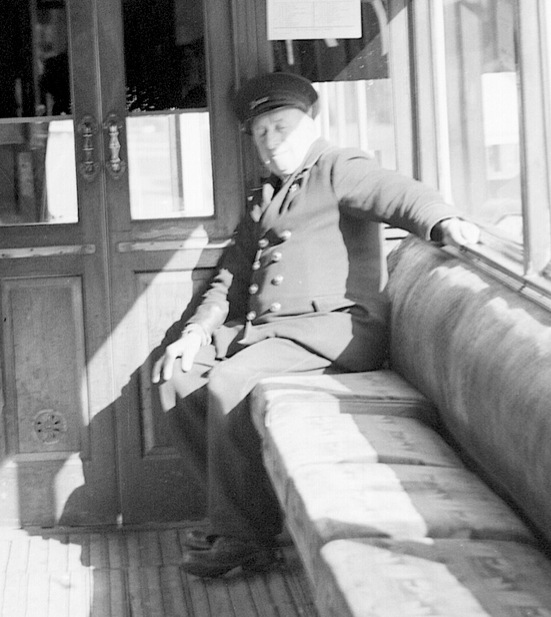
A motorman takes the opportunity for a brief snooze in the interior of Tramcar No 6 — 10th June 1955. Once again the cap carries a Driver script-lettering badge rather than the usual Motorman. This type of interior crew shot was seemingly a favourite of the photographer, M J O'Connor (courtesy of the National Tramway Museum). 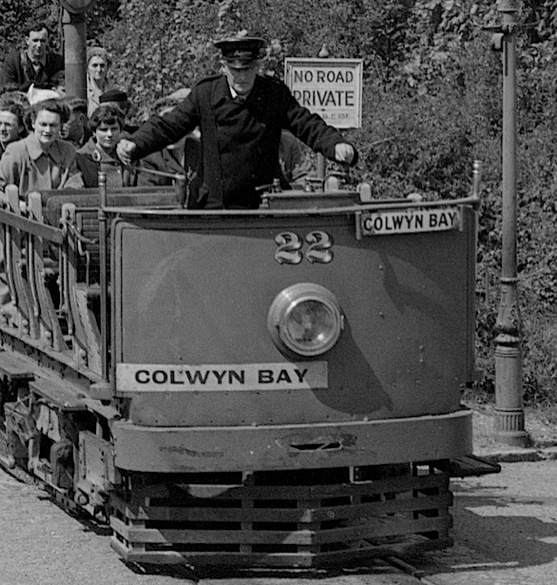
Another shot of Tramcar No 22, this time at Bodafon Crossing on 29th May 1955, evidently a chilly day given that the motorman is wearing a greatcoat (with passengers wrapped up too). Photo by M J O'Connor, courtesy of the National Tramway Museum. 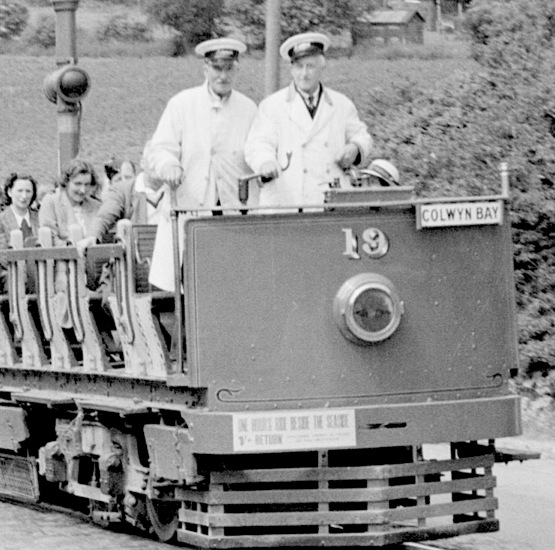
A motorman and a conductor in summer attire (light-coloured coats and white rain covers on their caps) ascending the Little Orme aboard Tramcar No 19 — photo undated, but probably taken in the 1950s. Photo by D W K Jones, courtesy of the National Tramway Museum.
Senior staff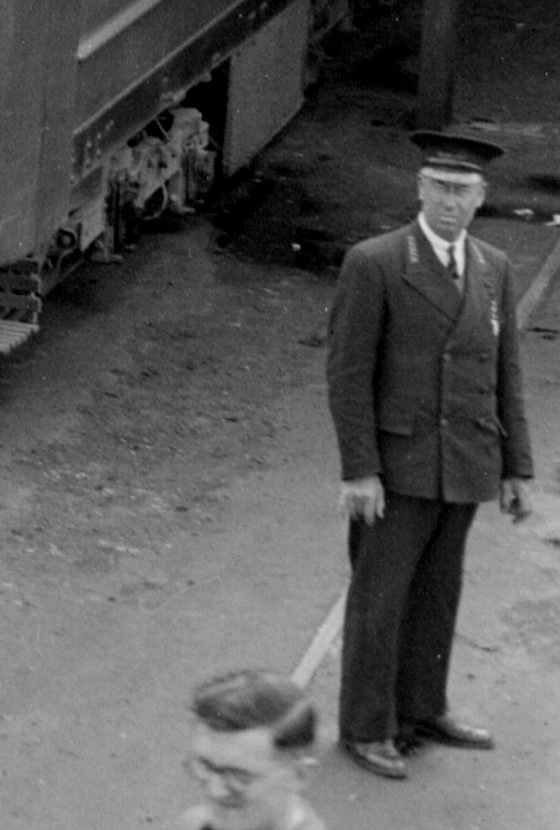
An inspector stands in the depot yard at Rhos (Tramcar No 5 behind him) — photo undated, but probably taken in the last few years before closure. Photo by D W K Jones, courtesy of the National Tramway Museum.
Female staff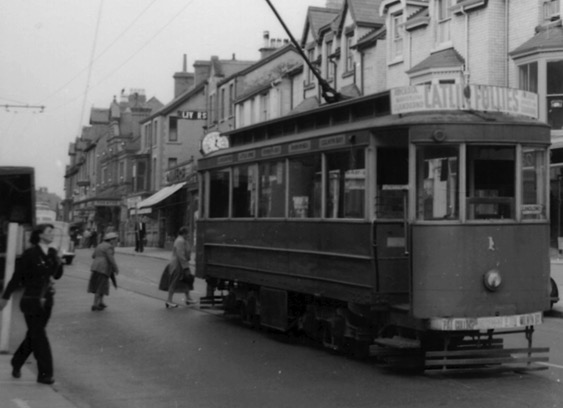
A poor quality but rare view showing an L&CBER conductress (extreme left) in the act of reversing the trolley pole of Tramcar No 1 (an ex Accrington vehicle) at the Conway Rd terminus in Colwyn Bay — photo undated, but probably taken in the 1940s. Photo courtesy of the Tramways and Light Railway Society, with thanks to David Voice.